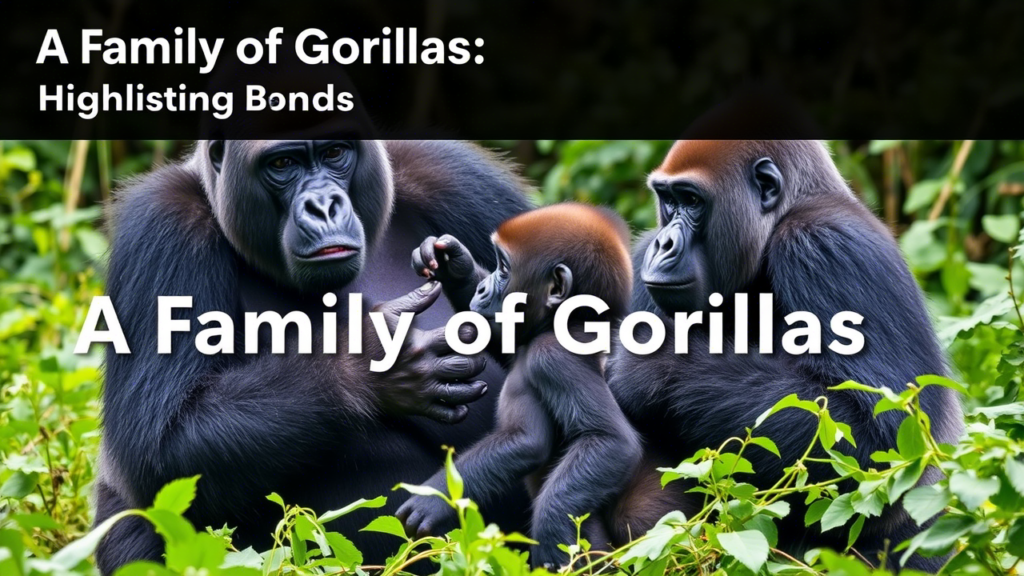Gorillas, one of humanity’s closest relatives in the animal kingdom, are fascinating creatures known for their intelligence, strength, and intricate social behavior.
But have you ever wondered what a group of gorillas is called? Understanding the terminology used to describe these majestic primates not only enriches our vocabulary but also deepens our appreciation for their unique way of life..
Understanding Collective Nouns
Before diving into the specifics of gorilla-related collective nouns, let’s clarify what collective nouns are. These are words or phrases used to describe groups of animals, people, or objects as a single entity. For example, a flock of birds or a pride of lions. When it comes to gorillas, there are multiple terms that can be applied depending on context and nuance.
The Most Common Collective Nouns for Gorillas
Here are some widely recognized terms:
- Troop of gorillas: This is perhaps the most commonly used term.
- Band of gorillas: Slightly less formal but equally valid.
- Family of gorillas: Emphasizes the close-knit relationships within the group.
Each of these terms highlights different aspects of gorilla group dynamics and their social behavior. Let’s break them down further.
A Troop of Gorillas: The Dominant Term

The phrase “a troop of gorillas” is by far the most prevalent way to refer to a group of these magnificent primates. Why “troop”? Well, the word evokes images of organized movement and unity—qualities that align perfectly with how gorillas operate in the wild.
Scenario Example: Wildlife Photography Email
Imagine you’re a wildlife photographer named Alex who recently captured stunning images of a troop of gorillas during an expedition in Rwanda. You decide to share your experience with fellow photographers via email:
Subject: Capturing the Majesty of a Troop of Gorillas
Hi Sarah,
I just returned from Volcanoes National Park, where I spent days observing a troop of gorillas led by a commanding silverback gorilla. Watching their foraging behavior was mesmerizing—they moved through dense vegetation with incredible coordination. Did you know that a dominant silverback plays a crucial role in maintaining order? His presence ensures harmony among the group members. Attached are some photos showcasing their playful behavior and gorilla grooming rituals. Let me know if you’d like to collaborate on a project about gorilla communication methods!
This example demonstrates how seamlessly the term “troop” fits into everyday language while emphasizing key aspects of gorilla social structure.
A Band of Gorillas: A Musical Metaphor
While “troop” dominates the lexicon, another charming option is “band of gorillas.” Though less frequently used, this term paints a vivid picture of gorillas moving together like musicians in sync—a metaphorical nod to their harmonious interactions.
Scenario Example: Conservation Newsletter
Suppose you work for a conservation organization and need to draft a newsletter update about recent findings in wildlife research:
Spotlight on Gorilla Behavior in the Wild
Recent studies reveal fascinating insights into the social behavior of a band of gorillas observed in Uganda’s Bwindi Impenetrable Forest. Researchers noted how young gorillas engaged in playful behavior, strengthening familial bonds essential for survival. Interestingly, the dominant silverback leadership style varies between troops, highlighting the complexity of gorilla group dynamics. By understanding these nuances, we can better protect their habitats and ensure ecological balance.
Using “band” here adds a poetic touch, making the description more engaging for readers.
A Family of Gorillas: Highlighting Bonds

Finally, referring to gorillas as a family underscores the emotional connections and loyalty shared within the group. This term resonates deeply because it mirrors human familial structures.
Scenario Example: Educational Blog Post
Consider writing a blog post aimed at educating readers about gorilla family bonds:
Why We Should Think of Gorillas as Families
When you think of a family of gorillas, imagine a tight-knit unit working together to survive. At the heart of every family is the silverback gorilla, whose protective instincts guide the group. Young gorillas learn vital skills through social learning, mimicking adults during tasks like foraging. Their herbivorous diet consists mainly of leaves, stems, and fruits, which they gather collaboratively. Even conflicts are resolved peacefully, thanks to the strong communication methods employed by all members. Next time you hear someone mention a name for group of gorillas, remember—it’s not just semantics; it reflects the profound bond they share.
By framing gorillas as families, we foster empathy and connection with these incredible beings.
Table: Comparing Collective Nouns for Gorillas
To summarize the distinctions between these terms, here’s a helpful table:
| Collective Noun | Connotation | Best Used In Context Of… |
|---|---|---|
| Troop of gorillas | Organized, militaristic | Describing structured group dynamics |
| Band of gorillas | Harmonious, rhythmic | Highlighting playful behavior and cooperation |
| Family of gorillas | Emotional, relational | Focusing on gorilla family bonds and closeness |
The Role of the Silverback in Gorilla Group Dynamics
No discussion of gorilla social structure would be complete without mentioning the pivotal role of the silverback gorilla. As the leader of the group, the silverback ensures safety, mediates disputes, and makes critical decisions regarding travel routes and feeding areas.
Scenario Example: Academic Research Paper Abstract
If you were drafting an abstract for a paper on gorilla behavior, you might write:
Abstract:
This study examines the influence of the dominant silverback on gorilla territory management. Observations conducted over six months revealed that the silverback’s strategic positioning minimizes resource competition and enhances ecosystem balance. Additionally, his involvement in gorilla grooming sessions fosters trust and cohesion within the family of gorillas. These findings underscore the importance of preserving habitats to support healthy group dynamics.
Such academic writing showcases the significance of the silverback in maintaining stability.
Playful Behavior in Gorillas: A Window Into Social Learning
Young gorillas often exhibit playful behavior, which serves as both entertainment and a means of developing essential life skills. Through wrestling matches, chasing games, and mock fights, they hone motor skills and strengthen social ties.
Scenario Example: Social Media Post
As a wildlife enthusiast sharing content on Instagram, you could caption a photo like this:
📸 Swipe left to see adorable moments of young gorillas at play! These interactions aren’t just fun—they’re vital for social learning. Notice how even the dominant silverback occasionally joins in, reinforcing his role as a mentor. Tag a friend who loves learning about gorilla communication! #WildlifePhotography #GorillaBehaviorInTheWild
Social media posts like this make complex topics accessible and relatable.
Conclusion: Celebrating the Complexity of Gorillas
From the structured hierarchy of a troop of gorillas to the intimate bonds of a family of gorillas, these collective nouns reflect the rich tapestry of gorilla social behavior. Whether you’re crafting emails, newsletters, or social media updates, choosing the right term depends on the story you want to tell. Remember, behind every gorilla collective noun troop, gorillas collective noun band, or name for group of gorillas, lies a world of wonder waiting to be explored.
So next time you encounter these gentle giants—whether in books, documentaries, or real life—take a moment to appreciate the intricate web of relationships that define their existence. After all, understanding their social structure brings us closer to protecting their future.
This comprehensive guide has covered everything from terminology to practical applications, ensuring readers walk away informed and inspired.

“Smith is the dedicated admin of [grammarprotips.com], a platform focused on enhancing grammar skills. With a passion for language and education, Smith strives to make grammar accessible and enjoyable for learners of all levels. Committed to delivering high-quality content, Smith continually explores innovative ways to help users master the complexities of grammar.”

